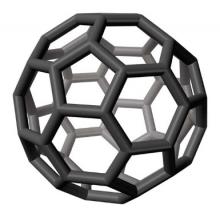More recently, Kato et al. demonstrated the antioxidant activity of C(60) incorporated into liposomes, with persistent scavenging of hydroxyl radicals and cytoprotection of keratinocytes against UVA- and UVB-induced damage ascribed to the fullerene component (J. Nanosci. Nanotechnol. 2011;11(5):3814-23).
Safety
The first study establishing the safety of highly purified fullerenes (HPFs) as an additive in cosmeceuticals was conducted in 2009. Aoshima et al. performed in vivo tests in animals and in vitro examinations using human epidermal keratinocytes and fibroblasts. No primary or cumulative skin irritation, sensitization, photosensitization, or contact phototoxicity was observed. In the patch test on human skin, no reaction was noted. HPFs were deemed to be "minimally irritating" after the eye-irritation test in rabbits. The investigators concluded, based on their findings and in light of previously published data, that HPFs are safe for human skin as ingredients in cosmetic skin care formulations (J. Toxicol. Sci. 2009;34(5):555-62).
Hair regrowth
In 2009, Zhou et al. used shaved mice and SKH-1 hairless mice to study whether fullerene-based compounds could elicit hair growth. Fullerenes were found to significantly increase the hair growth rate compared with a placebo vehicle. Significantly increased numbers of hair follicles were also observed in SKH-1 hairless mice treated topically or subdermally with fullerenes. Cultured human skin treated with fullerenes also showed augmented hair growth. The data suggested implications for hair loss due to alopecia, chemotherapy, or other chemical reactions (Nanomedicine 2009;5:202-7).
Antiacne properties
In 2011, Inui et al. conducted an open trial of effects of fullerene gel on acne. Subjects used the gel twice daily, and significant reductions in the mean number of inflammatory lesions were noted at 4 and 8 weeks of treatment. In addition, the researchers conducted in vitro assays of sebum production in hamster sebocytes and found that 75 mcM polyvinylpyrrolidone-fullerene suppressed sebum production, suggesting that topical fullerenes inhibit acne by reducing neutrophil infiltration and sebum production (Nanomedicine 2011;7:238-41).
Water solubility and photodynamic activity
In 2007, Mroz et al. compared the photodynamic activity of six fullerenes functionalized to become soluble with 1, 2, or 3 hydrophilic or 1, 2, or 3 cationic groups in three mouse cancer cell lines (J774, LLC, and CT26) incubated for 24 hours with fullerenes and illuminated with white light. They found that some functionalized fullerenes (particularly monopyrrolidinium fullerene) induced apoptosis in all cancer lines (Free Radic. Biol. Med. 2007;43:711-9). In a subsequent study, Mroz et al. found that some fullerenes can be functionalized to photoinactivate pathogenic malignant cancer cells and/or microbial cells in a mechanism that involves superoxide anion and singlet oxygen. The researchers suggested that fullerenes have the potential to supersede photosensitizers in current clinical use in PDT for some conditions (Photochem. Photobiol. Sci. 2007;6:1139-49).
In 2009, Yin et al. showed that three different functionalized water-soluble fullerenes can intercept and protect cells against all of the primary physiologically important ROS and can efficiently suppress lipid peroxidation in vitro. The findings suggest the potential of fullerene derivatives as effective cytoprotective therapeutic agents (Biomaterials. 2009;30:611-21), the researchers wrote.
Conclusion
The discovery of the fullerene family has stimulated widespread research in chemistry and biology for a broad range of therapeutic applications. Anti-inflammatory, antioxidant, and antiviral activities have been linked to these compounds. In addition, fullerenes appear to be effective in drug and gene delivery and as an adjunct in acne therapy. The compounds have shown potential as photoprotectants as well as photosensitizers, which may be useful in photodynamic therapy. More research is needed, but the potential applications of fullerenes in dermatology are promising, particularly as potent antioxidants conferring skin protection.
Dr. Baumann is in private practice in Miami Beach. She did not disclose any conflicts of interest.


